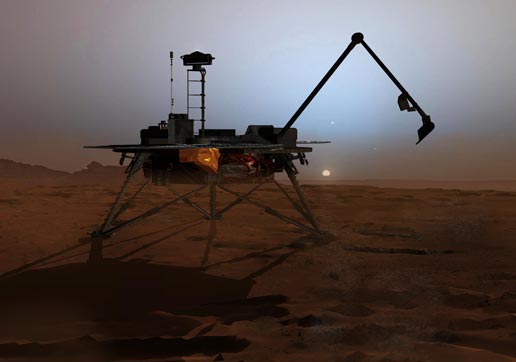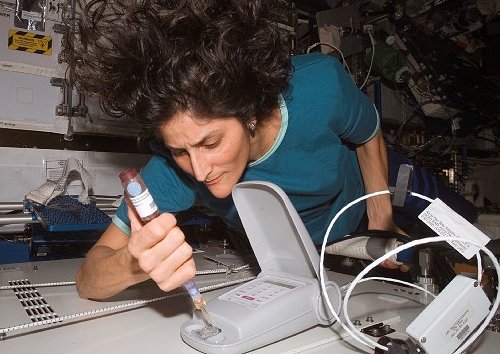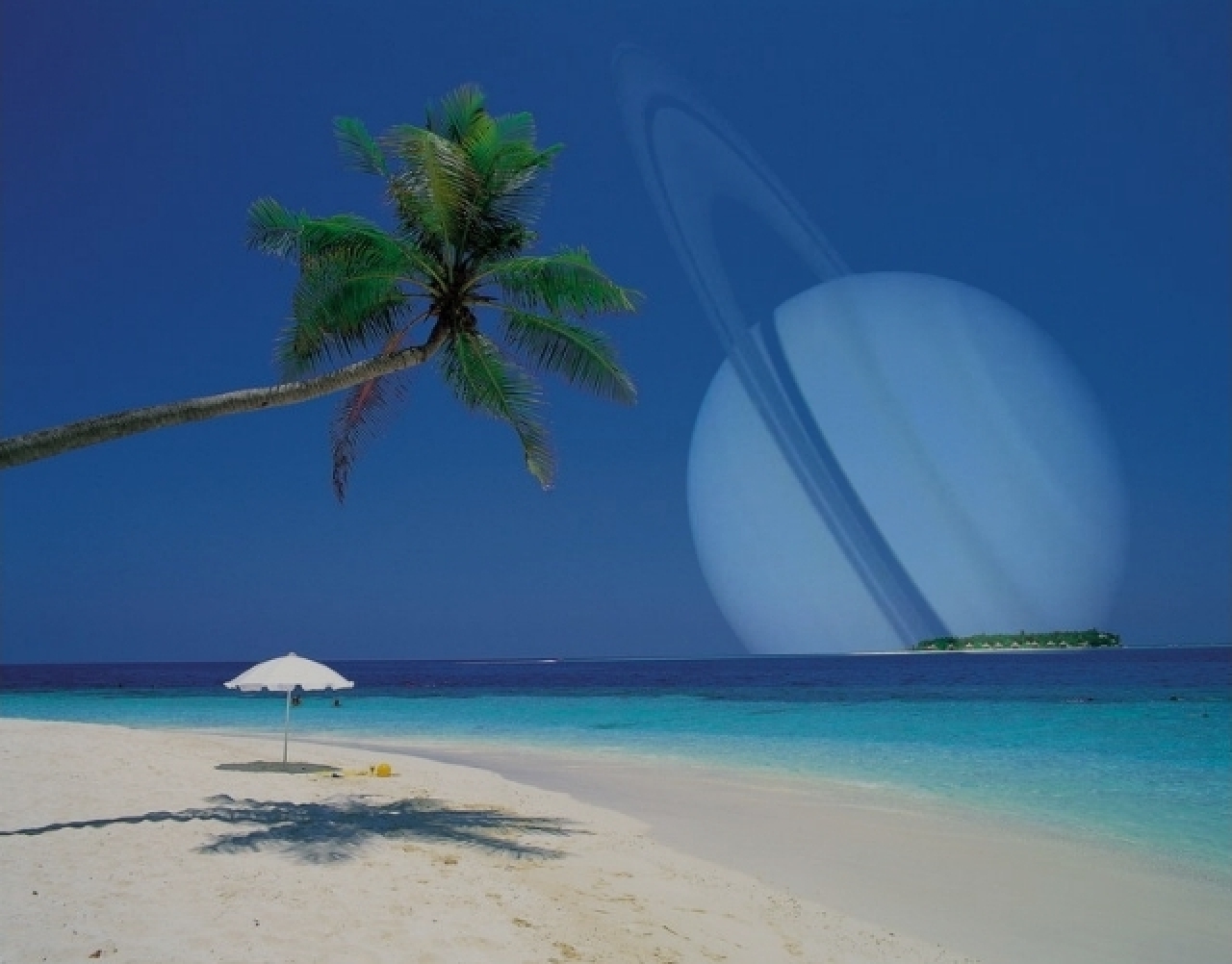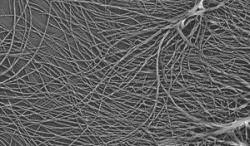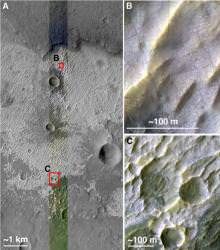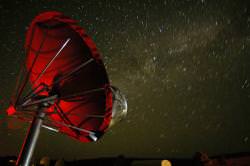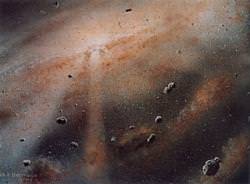The director of the Vatican observatory said it’s possible that intelligent life exists on other planets. And since aliens would be part of God’s creation, their existence would not contradict the Catholic faith. In an interview with the Vatican newspaper Rev. Jose Gabriel Funes discussed the Big Bang theory, as well as creation and evolution. The interview was originally published in Italian, but a priest from Holland translated the full interview to English and posted it on his website, FatherRoderick.com:
Continue reading “Vatican Astronomer Says Its OK to Believe in ET”
Imminent Discovery of Life On Mars?
Do you think there is life on Mars? Do you think Phoenix will find evidence of it? Now there’s a blog that’s trying to collect a snapshot of the opinions of scientists, amateurs, and everyday people. “Imminent Discovery” thinks Phoenix may find simple life. Finding this evidence will definitely become headlines… If it happens. Is it possible it might have originated from earth? Perhaps from space, like the famous Antarctica meteorite which was believed to contain evidence of life transported here from Mars?
According to Richard Trentman, a Minor Planet Coordinator at Powell Observatory, “The idea of life in some form on other planets, I believe is highly probable. I have studied about the extreme places on this planet where life has been found and many are far more extreme than may be found on Mars and other planets or moons in our solar system. I believe that anyone that thinks life cannot be “out there” has their eyes closed and blinders on.”
Over time, many astronomers have spent a lifetime dreaming of life and formations on Mars like the misguided Slipher: “Some form of vegetation exists. …The evidence is in the blue-green areas and the changes in their appearance. Vegetation would present exactly the appearance shown, and nothing we know of but vegetation could. The season change that sweeps over them is metabolic…” And yet others take more pragmatic views like astronaut Pete Conrad who commented on bacteria surviving on retrieved Surveyor III remains: “The most significant thing we ever found on the whole Moon was that little bacteria who came back and lived an nobody ever said (anything) about it.”
What’s your opinion? Help to update the book “Imminent Discovery, NASA’s Phoenix and the Secret of Life on Mars” in a post-discovery edition with some of these inputs. Please feel free to Post Your Thoughts On The Imminent Discovery of Life On Mars. Responses may be anonymous or you may use initials if you prefer. To make it more interesting, there is a random drawing of all individuals who enter comments to give away one copy of the classic 1962 book by Earl Slipher “Mars, the Photographic Story”, and a competition between astronomy clubs. Have fun!
“Tricorder” Checks for Unwanted ISS Microbes
Astronauts on board the space station now have their very own tricorder. While this 21st century version isn’t as versatile as its 24th century counterpart made famous in the Star Trek television series, it will help keep the ISS crew healthy. The real name of this device is LOCAD-PTS, short for Lab-On-a-Chip Application Development Portable Test System. It’s a handheld biological lab specifically designed to detect and identify microbes on space station surfaces.
Wherever there are humans, there are also microbes. Biologists estimate that every human body has at least a trillion hitchhiking microbes, accounting for as much as 2% of a person’s total mass. Most live in harmony with native human cells, but others cause illnesses.
LOCAD can currently detect E. coli, salmonella and fungi. Science@ NASA reports that some fungi can actually decompose electronics, and the ISS is full of electronics essential to maintaining the space station.
LOCAD uses specialized cartridges to find different types of microbes. By the end of the year new cartridges will be sent to the station that can detect staphylococcus and streptococcus.
Eventually scientists hope to have cartridges to detect all kinds of micro-organisms and chemical compounds, so that the device could be used to diagnose what kind of “bug” an astronaut might have if they become ill.
While the Star Trek tricorder could check vital signs and find alien life, LOCAD can be used on lunar missions, long duration stays on other planets, and also here on Earth to keep track of tiny lifeforms.
LOCAD actually looks more like the tricorder from Star Trek: the Next Generation.

Here’s an image of the tricorder from the original Star Trek in the 1960’s.
Original News Source: Science@NASA
Water in Interstellar Space
Water: it covers 70% of our own planet, it makes up 65% of our human bodies, and as far as we know, water seems to be essential for life. Water is also found in space, and in fact water ice is the most abundant solid material out there. But how did it get there, and how could water molecules possibly form in the freezing darkness of interstellar space? Japanese researchers trying to answer those questions say they have created water for the first time in conditions similar to interstellar space.
Water ice has been detected in our solar system on other planets and their moons, as well as in comets. A group of scientists at Japan’s Institute of Low Temperature Science at Hokkaido University say, “Since the solar system evolved from an interstellar molecular cloud, icy objects in the solar system originated from the water ice formed in the interstellar molecular cloud.” Their research was an attempt to gain an understanding of the origin of water molecules in interstellar clouds.
Water does form easily here in the warmth and abundance of Earth when oxygen and atomic hydrogen come together. But there’s not a lot of those elements floating around as gas in interstellar dust clouds. From their research, the group from Japan has concluded that water must form when atomic hydrogen interacts with frozen solid oxygen on a solid surface, such as dust grains in interstellar clouds.
They recreated this process by creating a layer of solid oxygen on an aluminum substrate at 10 degrees Kelvin and then added hydrogen. With infrared spectroscopy, they confirmed that both water and hydrogen peroxide formed, and in the right quantities to explain the abundance of water seen in interstellar clouds.
It’s interesting to note that the first water molecules in the universe must have started in this way, and that eventually led to water on Earth, then life, and then eventually people on Earth, who like to research, discuss and contemplate how it all began.
Original News Source: ArXiv, ArXiv blog
The Odds of Intelligent Life in the Universe
When it comes to contemplating the state of our universe, the question likely most prevalent on people’s minds is, “Is anyone else like us out there?” The famous Drake Equation, even when worked out with fairly moderate numbers, seemingly suggests the probable amount of intelligent, communicating civilizations could be quite numerous. But a new paper published by a scientist from the University of East Anglia suggests the odds of finding new life on other Earth-like planets are low, given the time it has taken for beings such as humans to evolve combined with the remaining life span of Earth.
Professor Andrew Watson says that structurally complex and intelligent life evolved relatively late on Earth, and in looking at the probability of the difficult and critical evolutionary steps that occurred in relation to the life span of Earth, provides an improved mathematical model for the evolution of intelligent life.
According to Watson, a limit to evolution is the habitability of Earth, and any other Earth-like planets, which will end as the sun brightens. Solar models predict that the brightness of the sun is increasing, while temperature models suggest that because of this the future life span of Earth will be “only” about another billion years, a short time compared to the four billion years since life first appeared on the planet.
“The Earth’s biosphere is now in its old age and this has implications for our understanding of the likelihood of complex life and intelligence arising on any given planet,” said Watson.
Some scientists believe the extreme age of the universe and its vast number of stars suggests that if the Earth is typical, extraterrestrial life should be common. Watson, however, believes the age of the universe is working against the odds.
“At present, Earth is the only example we have of a planet with life,” he said. “If we learned the planet would be habitable for a set period and that we had evolved early in this period, then even with a sample of one, we’d suspect that evolution from simple to complex and intelligent life was quite likely to occur. By contrast, we now believe that we evolved late in the habitable period, and this suggests that our evolution is rather unlikely. In fact, the timing of events is consistent with it being very rare indeed.”
Watson, it seems, takes the Fermi Paradox to heart in his considerations. The Fermi Paradox is the apparent contradiction between high estimates of the probability of the existence of extraterrestrial civilizations and the lack of evidence for, or contact with, such civilizations.
Watson suggests the number of evolutionary steps needed to create intelligent life, in the case of humans, is four. These include the emergence of single-celled bacteria, complex cells, specialized cells allowing complex life forms, and intelligent life with an established language.
“Complex life is separated from the simplest life forms by several very unlikely steps and therefore will be much less common. Intelligence is one step further, so it is much less common still,” said Prof Watson.
Watson’s model suggests an upper limit for the probability of each step occurring is 10 per cent or less, so the chances of intelligent life emerging is low — less than 0.01 per cent over four billion years.
Each step is independent of the other and can only take place after the previous steps in the sequence have occurred. They tend to be evenly spaced through Earth’s history and this is consistent with some of the major transitions identified in the evolution of life on Earth.
Here is more about the Drake Equation.
Here is more information about the Fermi Paradox.
Original News Source: University of East Anglia Press Release
Want to Find Evidence of Life on Another Planet? Look for Cellulose
Until recently, the oldest evidence of biological material on Earth came from fragments of ancient protein found in Tyrannosaurus Rex dinosaur fossils, dated at 68 million years old. But scientists from the University of North Carolina have found even more ancient biological material — cellulose microfibers—that date to over 250 million years old. These samples of cellulose were found in pristine ancient salt deposits deep beneath the New Mexico desert. This finding comes on the heels of researchers finding huge salt deposits on Mars with the Odyssey orbiter, as well as the Mars Exploration Rover Spirit finding a patch of bright soil that’s believed to be rich with salt. Combined, these findings may help point out destinations for future Mars missions looking for past life on the Red Planet.
“In looking for evidence of life on Mars, for bacteria or higher plants that existed on Mars or another planet in the solar system, then looking for cellulose in salt deposits is probably a very good way to go,†said Jack D. Griffith, Ph.D., from UNC who found the cellulose microfibers. “Cellulose appears to be highly stable and more resistant to ionizing radiation than DNA. And if it is relatively resistant to harsh conditions such as those found in space, it may provide the ideal ‘paper trail’ in the search for life on other planets.â€
Cellulose is the major structural component of plant matter and is very tough and resilient. Cellulose is one of the most abundant biological materials on Earth, with plants, algae and bacteria generating an estimated 100 gigatons each year.
The salt samples retrieved by Griffith are from an underground repository for nuclear waste, about 2,000 feet below the surface. In examining the content of fluid salt and salt crystals with an electron microscope, Griffith and his team found abundant cellulose microfibers that were “remarkably intact.â€
The cellulose microfibers were as small as five nanometers in diameter, but also, there were tangles of the fibers, creating ropes and mats . “The cellulose we isolated from the ancient salt deposits is very much like real, modern day cellulose: it looks like cellulose, behaves like cellulose, it’s chopped up by the same enzymes that cut modern day cellulose and it’s very intact,†Griffith said.
Griffith said DNA was also was observed, but in much lesser amounts than cellulose.
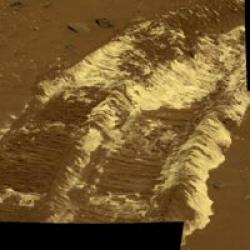
Whether life ever existed on Mars is the biggest scientific question driving Mars research. Scientists think the salt deposits formed on Mars approximately 3.5 to 3.9 billion years ago. “By their nature, salt deposits point to a lot of water, which potentially could remain standing in pools as it evaporates,” said Phil Christensen, principal investigator for Mars Odyssey spacecraft’s Thermal Emission Imaging System. “That’s crucial. For life, it’s all about a habitat that endures for some time.”
Whether there was enough time for biological life to develop on Mars is the big question hoped to be answered by the Phoenix mission, which will soon land on Mars’ polar region on May 25, 2008 and the future Mars Science Laboratory mission, tentatively scheduled to launch in 2009.
Original News Source: Physorg.com
Is Our Universe Ruled by Artificial Intelligence?
Science fiction is filled with unusual alien species. But apart from the occasional robot, biological life is running the show. But NASA scientist, Dr. Steven Dick, sees a future Universe that has evolved past biology. Where every intelligence is artificial. Consider the likelihood of a postbiological Universe.
Does intelligent life exist beyond Earth? It’s easily the most profound and challenging question that humans have ever asked. The consequences of discovering other intelligent life would ripple through every aspect of human society, and actually meeting another species would be even more challenging.
But are there abundant intelligent life forms out there? Or is the biological life on Earth just a stage? Just a single step towards our inevitable technological existence.
In a recent paper published in the journal Acta Astronautica, entitled The Post Biological Universe, Dr. Steven Dick notes how every search for extraterrestrial intelligence assumes that life will be biological. And yet, here on Earth we can see that intelligent life develops more and more sophisticated tools over time. And these tools will eventually lead to artificial intelligence that outstrips its makers.
If extraterrestrials are out there, they likely live in much older civilizations than ours, and have already transitioned through biology and into technology. The majority of worlds out there are already postbiological.
According to many scientists, it’s easy for civilizations to be older than us. The first metal rich stars with terrestrial planets could have formed a billion years after the Big Bang – 12.5 billion years ago. If intelligent life took another 5 billion years to evolve, just like it did here on Earth, that still means life could have been around for 7.5 billion years.
Plenty of time to evolve into intelligent life, and then transition into artificial intelligence.
Cultural advancement also seems to be an inevitable consequence of evolution. Not just humans, but many animals, such as chimpanzees have demonstrated that technology can be developed, improved and passed down from generation to generation.
Here’s a quote from the paper,
Hans Moravec, a highly respected AI pioneer and robotic expert at Carnegie-Mellon, predicted “What awaits is not oblivion but rather a future which, from our present vantage point, is best described by the words ‘postbiological’ or even ‘supernatural’. It is a world in which the human race has been swept away by the tide of cultural change, usurped by its own artiï¬cial progeny.” Our machines, Moravec predicted, will eventually transcend us, and be “released from the plodding pace of biological evolution.”
How could this change the search for extraterrestrials? Well, when you’re looking for robots, you can look anywhere. Dr. Dick suggests that the SETI community consider the environmental tolerance of robots and the availability of resources beyond planets. AI will be looking for places that provide the most raw material and energy – think quasars, not habitable planets.
Postbiologicals probably have no interesting talking with us regular biologicals. But it might be possible for us to intercept their communications if we know what we’re looking for.
He also thinks that postbiologicals might be more interested in receiving our communications, that talking to us. We should consider very special messages that we might want to send out to the AI civilizations.
Of course, the difference between our minds and theirs might be so great that communication is impossible.
But it doesn’t hurt to try.
Original Source: Acta Astronautica
Salt Deposits on Mars Might Be the Right Place to Search for Life
Researchers announced today that they have discovered large salt deposits on the surface of Mars. These deposits point to places where large quantities of water existed on the surface of the Red Planet, perhaps for millions of years. And this might be some of the best places to go looking for evidence of life, past and present.
A team led by Mikki Osterloo at the University of Hawaii, Honolulu have turned up approximately 200 separate spots on southern Mars that seem to have ancient deposits of sodium chloride. In other words, they’ve found table salt sitting on the surface of Mars.
The sites, discovered by NASA’s Mars Odyssey spacecraft, range in size from 1 square km (.6 square miles) to 25 square kms.
So how did this salt get there? One possibility is that it came from groundwater, reaching the surface in low spots. The water would evaporate and leave the mineral deposits over the course of millions of years. Since the sites are largely disconnected from one another, it rules out the possibility the salt was left by an ocean that evaporated billions of years ago.
“Many of the deposits lie in basins with channels leading into them,” said Philip Christensen, co-author and principal investigator for the camera at Arizona State University. “This is the kind of feature, like salt-pan deposits on Earth, that’s consistent with water flowing in over a long time.”
Don’t go looking for life today, though. The scientists think the salt deposits were formed approximately 3.5 to 3.9 billion years ago. This was a time when Mars had much warmer and wetter conditions than the frigid, dry climate on the planet today.
Until now, researchers have been looking for other evidence of past water on the surface of Mars, like clay or sulfate minerals. Clay is evidence that a region was weathered by water, and sulfates are caused by water evaporation. These salts offer an alternative place to look for evidence of past life.
To get salt deposits of this size, you would need to have large quantities of water sitting on the surface of Mars for a long time. And this is crucial in the search for life. You want a habitat that endures for a long time.
Original Source: NASA/JPL News Release
Making the Best First Impression, with Aliens
Did you know the SETI Institute has a Director of Interstellar Message Composition? I did not know that. I guess it makes sense. If we’re going to be communicating with aliens, we’ll want to be careful about the words we choose. Get it right, and we’ve got extraterrestrial friends, here to uplift us to the galactic community. Get it wrong and we might be looking at radio silence, or worse…
So how should we present ourselves to prospective galactic neighbours?
Douglas Vakoch, the aforementioned Director of Interstellar Message Composition at the SETI Institute has done some thinking about this, and recently wrote it up in an article entitled, How we Present Ourselves to Aliens.
The trick, of course, is to make a good first impression. When the aliens finally receive our first communications, we want them to be wowed. But should we hide our more violent tendencies, or is the best strategy to just be honest. Sure, we fight a few wars here and there, but that’s just a phase we’re working through.
Vakoch thinks that honesty is the best policy. Sure we’re flawed, but what member of the Milky Way club didn’t ravage society with constant warfare and nearly destroy their environment before they reached perfection?
The aliens might be touched at our honestly, recalling their own struggle to get to a stable, peaceful society. Or they might just send in the berserkers to wipe the violent apes off the planet.
And how should we communicate? Could we just transmit CAT-scans of the human body, demonstrating both our physique and level of technology. Or should the mathematicians do our talking for us, communicating in terms of pi until we’ve a mutual mathematical appreciation happening. Do we send our beautiful music, hoping their like it? But what if they hate it?
Whatever we say, and however we say it, that first impression is everything.
So let me know. What would you say, and how would you say it? And if the aliens actually replied, what would we do then?
Original Source: SETI Institute
Meteorites Can Be Rich With the Ingredients of Life
How did life arise on Earth? How did we get from rocks and water to the abundance and variety that we see today? Perhaps the raw ingredients for life, amino acids, were delivered to Earth by a steady bombardment of meteorites. Researchers have turned up space rocks with concentrations of amino acids 10x higher than previously measured, raising hopes that the early Solar System was awash in organic material.
The study was done by Marilyn Fogel of Carnegie’s Geophysical Laboratory and Conel Alexander of the Department of Terrestrial Magnetism with Zita Martins of Imperial College London and two colleagues, and will be published in Meteoritics and Planetary Science.
If you’re like me, the astronomy stuff’s fine, but the biology news is a little baffling (I forward the kids’ biology questions to my wife). Amino acids are organic molecules that form the backbone of proteins, which make much of life’s structures and drive chemical reactions in cells. Amino acids are naturally occurring, but they somehow came together to make the first proteins in the Earth’s early days.
The researchers took samples from three meteorites collected during recent expeditions to Antarctica. The meteorites are from a type called CR chondrites, which are through to contain ancient organic materials that date back to the earliest times of the Solar System. At one point, these meteorites were part of a larger “parent body”, which was later shattered by impacts.
One sample had few amino acids, but the other two had the highest concentration ever seen in primitive meteorites.
“The amino acids probably formed within the parent body before it broke up,†says Alexander. “For instance. ammonia and other chemical precursors from the solar nebula, or even the interstellar medium, could have combined in the presence of water to make the amino acids. Then, after the break up, some of the fragments could have showered down onto the Earth and the other terrestrial planets. These same precursors are likely to have been present in other primitive bodies, such as comets, that were also raining material onto the early Earth. â€
So this points to the conclusion that the early Solar System was a much richer source of organic molecules than researchers previously believed. And the constant rain of amino acid-laden meteorites would have delivered this material to the primordial soup where life first emerged.
Exactly how the amino acids became the first proteins… that’s still one of the biggest mysteries in science.
Original Source: Carnegie Institution for Science News Release

